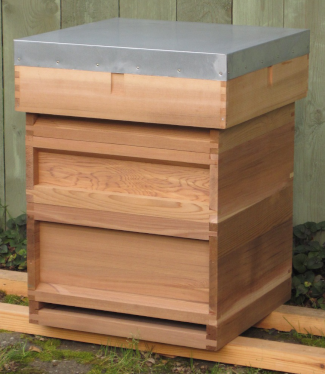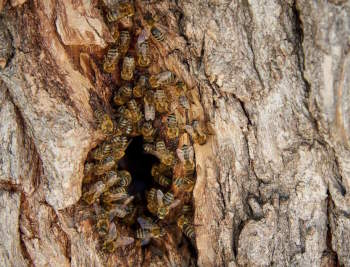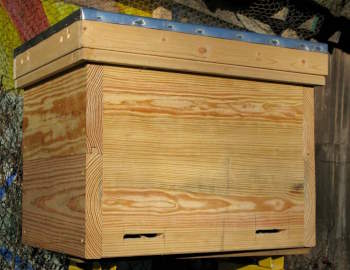Introduction
Bee-keepers have probably been arguing about which is the best hive design for as long as there have been bee-hives and with the invention of the movable frame hive in the mid 19th century those arguments intensified. Bee-keeping periodicals from the second half of the 19th century are full of these debates and those debates continue to this day in online forums. The advent of the internet means we have access more information than ever before, not that that necessarily makes it easier to decide between the options. The truth is probably that there is no perfect hive but there might be hives that are better suited to particular climates, to different bee-keepers and types of bee-keeping. What follows is my thinking as I try to sift through the options trying to work out what will suit me best.
First some background about myself. I first tried keeping bees in my early thirties when I was given a National Hive and some bees. I really didn’t know anything about keeping bees but I managed to get the bees through a couple of seasons fairly successfully. When I moved house toward the end of the third season I gave the bees and hive to the landowner on whose land I was keeping them. I always wanted to have another go and now 20 odd years later I’ve the time and space to try again. As well as being older I also have a back injury which means I don’t want to be lifting heavy hive boxes. I have a small piece of land (4 acres) where I can keep hives permanently sited and have no intention of attempting to move hives to different crops. Nor am I trying to keep bees commercially although if I’m going to keep bees I’m certainly hoping for a little surplus honey I could set against any costs. So what will suit me best?
The National Hive

I’ve already mentioned the ‘National’ hive which is the most common bee-hive in the UK (I believe the design was standardised around the time of WWII). Like the other common beehives, the Langstroth in the USA and the Dadant which was the most common hive in the Soviet Union, the National is a set of stackable boxes which house moveable frames on which the bees live, raise their brood and store honey. The brood boxes are located below the boxes storing honey (called supers) and management involves adding supers to collect honey and removing them when full with inspection of the brood area requiring the lifting away of the boxes above. For me, due to a back injury (advancing age might become a factor to at some point), it’s the lifting of boxes both for inspection and honey harvest that I want to avoid and this is the reason I began looking for alternatives.
The Kenyan Top Bar Hive (KTBH)
This was the first alternative that caught my eye and I was really drawn to its simplicity; whatever hive I chose I’m going to be building it myself and the KTBH looked like a fairly simple undertaking. The KTBH is essentially a shallow trough on legs with a lid. Beneath the lid, sitting across the top of the trough are the ‘top bars’ from which the bees are encouraged to draw comb (a small starter strip of beeswax foundation is attached to the underside of the bars and the bees take the hint and build their comb accordingly). There are no frames and once the comb is drawn and full it needs to be handled carefully in order to avoid it combing detached from the bars. I did come across someone who was adding wood to support the edges of the comb which looked like a good idea. This sort of hive is called a horizontal or long hive, with all the combs at one level rather than stacked above each other. Set on legs such a hive can be at a height most suited to the bee-keeper making managing these hives accessible even to someone in a wheel chair and certainly possible for someone like myself who struggles with a back injury. Sounds great but there are some problems.

As well as the fragility of the comb all my reading suggested that these combs might not be deep enough to be ideal for wintering bees in a colder northern climate. In fact one person suggested to me that the hive had been designed for the African bee, Apis Mellifera Scutellata, which is smaller than our native Apis Mellifera Mellifera and also lives in a much warmer climate. And this discussion led me into thinking about insulation in beehives.
What Would Wild Bees Choose?
Wild bees live in cavities in trees. Often these cavities form when the centre of an old tree rots but the cavity is surrounded by a thick layer of sound wood and the living outer layers, meaning its incredibly well insulated. Researchers have suggested that bees living in a tree cavity may be able to maintain a temperature within the nest of 12OC when the external temperature is as low as -40OC. For a conventional uninsulated hive the bees struggle to maintain the temperature at 12OC when the temperature drops to just 4OC1. In fact better insulated hives have a whole range of benefits that extend well beyond better winter survival.
There’s some research to show a warmer hive can safely maintain a more humid atmosphere and its been suggested that this may help restrict varroa in the hive.2 Researchers have shown that a better insulated hive improves the ability of bees to ‘ripen’ honey. The bees ‘ripen’ honey by distributing the gathered nectar across the combs in the hive and then circulating air within the hive in order to reduce the moisture content of the nectar thereby creating honey. This activity is often carried out in the evening or night when outside temperatures are lower. In an insulated hive its easier for the bees to maintain a suitable temperature for honey ripening and so the process is more efficient.3

In fact insulation seems to improve the ‘efficiency’ of the hive more generally. According to Torben Schiffer a well insulated hive requires less ‘fuel’ to maintain the colony, meaning the bees spend less time foraging and instead, ‘they turn to cleaning the hive, propolising (sterilising) the walls, grooming mites off each other, and inspecting brood for signs of disease.’4 Much of the research on hive insulation has been carried out by researchers looking at wild bees but that research is starting to impact on hive design. It’s now possible to buy ‘National’ hives made of polystyrene but at this point I’m pretty sold on a horizontal hive and even if I wasn’t I’d rather not be adding to the plastic in the environment. So I started looking about and came across the Layens hive.
The Layens Hive
The French botanist and apiculturist Georges de Layens is often credited with inventing the ‘Layens’ hive, although I believe he simply refined and popularised a pre-existing design. The Layen’s hive is a horizontal hive but unlike the KTBH it uses frames which are deep and narrow. In fact this sort of hive exists across much of Europe; there’s a Ukranian version which has much bigger (deeper and wider) frames, a version in Poland with a deep but narrower frame, versions in both Germany and Turkey that have two rows of frames separated by a queen excluder, etc. These latter designs are like two long hives side by side and they look both very large and very heavy. The design Layens popularised is fairly versatile and he showed various configurations for the hive in which honey production was more obviously prioritised, for instance with the addition of supers. For me the simple Layens hive, holding 14 to 18 frames looks about right.

So what’s leading me in that direction? I like the simplicity of the long hive. It looks like a design that would be relatively simple to build. The deep frame which is taller than it is wide is good for wintering a colony on. The use of insulated follower boards (these are boards that fit parallel to the frames to section off parts of the hive that that bees don’t need meaning the internal dimension of the hive can be varied) alongside well insulated walls might not precisely match the qualities of a tree cavity but would certainly be better than many hives in terms of thermal efficiency and minimising the energy the bees need to maintain the colony. These hives are heavy but as I’m not anticipating moving hives to new sites through the season I don’t see that as a great disadvantage. But is there a better alternative for me?
A possible alternative would be some sort of compact vertical hive (CVH). A CVH works in a similar way to the more familiar Nationals, Langstroths etc but its much smaller and therefor the boxes are lighter. The original CVH is probably the Warre hive, invented by another Frenchman, Emile Warre and named ‘The People’s Hive’. The Warre hive has internal dimensions of 300mm by 300mm compared to 374mm by 422mm for a National hive. Warre’s idea was that these dimensions better match those of the tree cavities in which wild bees live. The hive used top bars rather than frames making these hives easy to build with very basic tools. Management involved adding boxes to the bottom of the stack as the colony grew, rather than adding boxes to the top as is more common with other vertical hive designs. Warre felt this helped maintain the internal climate of the hive i.e. its warmth and humidity and he may well have been right in that but for me (or anyone else with back problems) that’s probably not going to work. However a quick internet search turns up plenty of people using hives with a 300mm by 300mm internal dimension.
Many of the examples I’ve seen are built by individual beekeepers to suit their own situation. Maybe they don’t want to deal with large heavy boxes, for others they’re moving hives from one crop to another through the season and these small footprint hives make that easier. I’ve come across people using very shallow frames /boxes but also someone using a ‘Ukranian’ sized frame in a very deep 300mm by 300mm box. Many of the makers are using their own custom made frames but a few seem to be finding ways to be compatible with more common equipment, something that’s certainly worth thinking about, especially if one plans to be extracting a lot of honey. My issue, beyond the fact that any vertical hive is going to require a fair amount of lifting and carrying is that once you add significant insulation the box size grows appreciably and the ease of handling that made the idea appealing diminishes.
I can be fairly obsessive and could have continued trawling through hive designs almost ad-infinitum (I found a website detailing over 300 designs) although most are variations on a theme and possibly many of these are regional variations shaped by local conditions. Some looked great – its easy to be seduced by complexity – but totally unsuited to my situation. And as I said at the start there’s no perfect hive, only hives that are a better fit to a person’s situation, climate etc. Then in the middle of all these deliberations I was given a modified Layens with some bees and the decision was made for me. Of course I’m not planning to keep just one hive and so now all that’s left to do is for me to ‘design’ the Layens hive I’m going to build.
